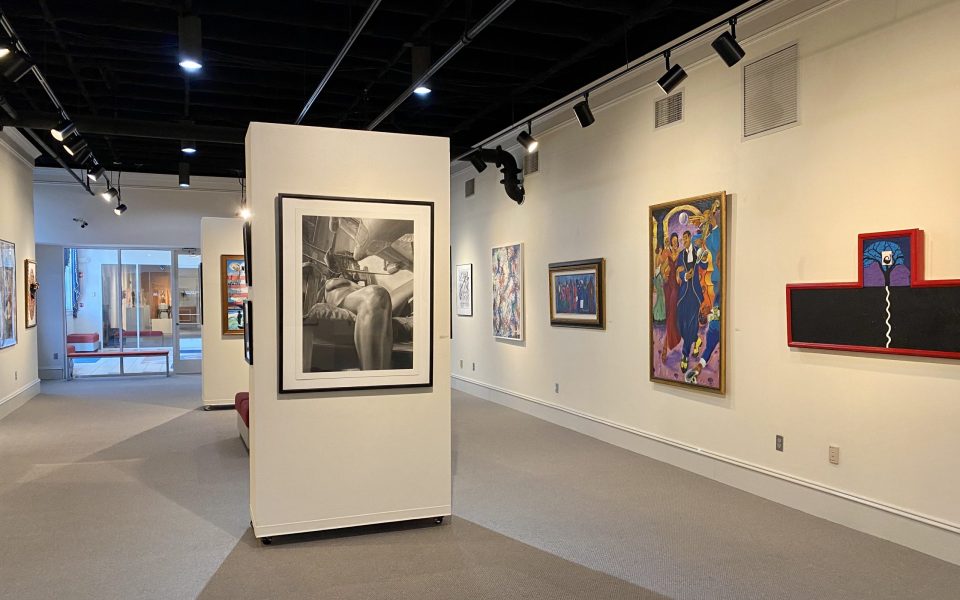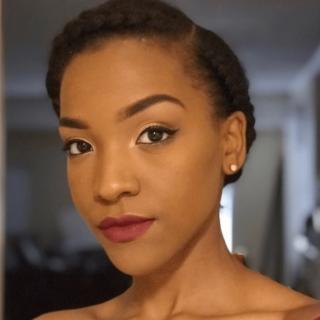Featured photo: Common Roots, Many Branches opened at NCA&T State University earlier this month. (photo by Michaela Ratliff)
Artist Shameka Manson gained more than an education during her time at NC A&T State University.
“[He] has become like a second father to me over the past 10 years,” she says of Willie F. Hooker, professor and art education coordinator at A&T. “I love learning from and working with him.”
The close relationships between college students and their professors is explored in Common Roots, Many Branches, an art show that opened in the University Galleries at NC A&T on March 20 and runs until April 14. The showing features more than 60 works by current and former visual-art faculty members and students representing the National Alliance of Artists from Historically Black Colleges and Universities, a nonprofit that educates and promotes artists and art programs at HBCUs. Fourteen universities are represented in the exhibition, including Winston-Salem State University. Its stop at A&T is just one of many for the touring exhibition, first displaying at the ArtWorks in Wilmington in January 2022.
The walls of the gallery and free-standing columns are decorated with pieces ranging in size, from painted portraits to mixed-media sculptures. Next to each piece is a label with its title, the name of the artist, the professor involved with collaboration or supervision on the piece and the university they represent.
Manson received her bachelor’s in art education from NC A&T in May 2018. She first met Hooker when he became her academic advisor; he asked her to appear under his branch of former students in the exhibition. Together, they chose Manson’s mixed-media piece, The “Timeline of Pan-Africanism,” to appear in the exhibition.

In the piece, Manson combines bits of her heritage — kente-cloth patterns, a Mesopotamian necklace and Hebrew earrings — to depict her identity as an African-American and Garifuna woman. The subject of the painting stares at the viewer with piercing eyes. Her multi-textile turban, dangling tassel earrings and powerful facial expression exude royalty. At first glance, the subject’s eyes appear to reflect light, but a closer look reveals a message from Manson.
“They say the eyes are the windows to the soul, so I painted an African continent within the eyes,” she says. “At heart, we are all African regardless of where we got displaced.”
The subject is painted on black paper, and resting behind her are racial slurs painted in black letters. With the exception of “black-eyed pea,” none of the slurs are completely spelled out. Manson originally wanted to spell “African” multiple ways, but came across more slurs than positive translations.
“This made me think about how, as Black people, we can beautify ourselves as much as possible and be strong, but no matter how much we try to ignore the words, we always take a mental note in our subconscious about what we get called on a daily basis,” she says.
While Manson completed the piece alone, she consulted Hooker for advice throughout its creation.
“He’s one of the first people I send my artwork to for feedback,” she says.
Maya Stewart, a freshman bioengineering student at A&T, visited the gallery after a morning of classes. She was drawn to “Attack on Sitting Pose,” a black-and-white charcoal on paper by James Pate and accompanying professor Willis “Bing” Davis from Central State University in Wilberforce, Ohio. In the work, a nude Black woman rests in a chair as a plane heads in her direction. According to Stewart, this represents criticism Black women face just for existing.

“We’re constantly being attacked for being still and we have to be the bigger person and turn the other cheek,” she says.
Stewart also hypothesized the subject’s nakedness represents the forcing of the Jezebel stereotype on Black women.
“It represents us being vulnerable but being looked at as property and constantly being sexualized,” she says.
While the exhibition represents professors and their protégés sharing a common root of art, Common Roots also presents the many branches of Black history stemming from one common place: enslavement in the United States.
In mixed media sculpture “Four Hundred Years of Slavery,” Hooker portrays a pair of Black feet enclosed in gold shackles against a multicolored, textured background. In “Divine Nine,” Sam. D Burston and accompanying professor Dr. Lee Ransaw from Morris Brown College in Atlanta pay homage to the nine historically-Black Greek letter organizations. In the painting, nine faceless figures are dressed in their Sunday best, wearing their organization’s colors and standing in order by the year each organization was founded.

Though she’s no longer his student, Manson still appreciates her mentor Hooker’s encouragement of free-thinking.
“He’s definitely the best professor I’ve ever had because his teaching style is so broad, and he leaves the subject matter to the student,” she says.
Common Roots, Many Branches is on display in the University Galleries until April 14. A second viewing will be available in the galleries May 12 through July 28. The University Galleries are open Monday-Friday, 10 a.m-5 p.m. and Saturdays by appointment. Exhibitions are free and open to the public. Learn more about the National Alliance of Artists from Historically Black Colleges and Universities at naahbcu.com. Visit Shameka Manson’s website at shamekamanson.square.site.
Join the First Amendment Society, a membership that goes directly to funding TCB‘s newsroom.
We believe that reporting can save the world.
The TCB First Amendment Society recognizes the vital role of a free, unfettered press with a bundling of local experiences designed to build community, and unique engagements with our newsroom that will help you understand, and shape, local journalism’s critical role in uplifting the people in our cities.
All revenue goes directly into the newsroom as reporters’ salaries and freelance commissions.


Leave a Reply